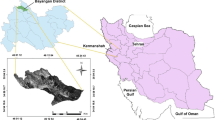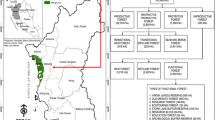Abstract
Nowadays, taking advantage of multispectral sensors with the high spatial and spectral resolution and using a variety of plant indices and remote sensing have provided the possibility of more accurate analysis and classification of satellite data in the identification of natural phenomena. Nowadays, obtaining information about the structure of forests through remote sensing data to manage renewable resources is of interest to managers and researchers. This study produced the development maps of natural forests in northern Iran by taking advantage of GeoEye-1 data, training samples, and various algorithms through the pixel-based, object-based, and model-based methods. The classification’s ultimate accuracy was calculated by each of the above methods with the overall accuracy parameters and kappa coefficient. By examining the accuracy of map classification resulting from different methods, the maximum accuracy (78%) in object-based method was estimated based on the segmentation of NDVI and the maximum likelihood algorithm. Meanwhile, some other classification methods showed much less accuracy. The results showed that the algorithms following the structural patterns for pixel distribution classification provided a higher accuracy. Also, these results showed the high potential of high-resolution data from GeoEye-1 in the production of forest development maps and the effect of choosing the appropriate algorithm in the production of higher accuracy maps.




Similar content being viewed by others
References
Abdollahnejad, A., Panagiotidis, D., & Surov, P. (2017). Forest canopy density assessment using different approaches–Review. Journal of Forest Science, 63(3), 107–116.
Akhavan, R., Sagheb-Talebi, K., Zenner, E. K., & Safavimanesh, F. (2012). Spatial patterns in different forest development stages of an intact old-growth oriental beech forest in the Caspian region of Iran. European Journal of Forest Research, 131(5), 1355–1366.
Al-Doski, J., Mansorl, S. B., & Shafri, H. Z. M. (2013). Image classification in remote sensing. Department of Civil Engineering, Faculty of Engineering, University Putra, Malaysia. Journal of Environment and Earth Science, 3(10), 141–148.
Amiri, N. (2013). Evaluation of different change detection techniques in forestry for improvement of spatial objects extraction algorithms by very high resolution remote sensing digital imagery. International Archives of the Photogrammetry, Remote Sensing and Spatial Information Sciences, Volume XL-1/W3, 2013 SMPR 2013, 5–8 October 2013, Tehran, Iran, 43-47.
Baatz, M., & Schäpe, A. (2000). Multi resolution segmentation: an optimum approach for high quality multi scale image segmentation. In Beutrage zum AGIT-Symposium. Salzburg, Heidelberg, 12-23.
Baumann, M., Ozdogan, M., Wolter, P. T., Krylov, A., Vladimirova, N., & Radeloff, V. C. (2014). Landsat remote sensing of forest windfall disturbance. Remote sensing of environment, 143, 171–179.
Blaschke, T. (2010). Object based image analysis for remote sensing. ISPRS journal of photogrammetry and remote sensing, 65(1), 2–16.
Bulut, S., Günlü, A., & Keleş, S. (2019). Estimation of forest development stage and crown closure using different classification methods and satellite images: a case study from Turkey. Journal of Forest Science, 65(1), 18–26.
Campbell, J. B., & Wynne, R. H. (2011). Introduction to remote sensing (5th ed.p. 717). The Guilford press.
Chen, G., & Meentemeyer, R. K. (2016). Remote sensing of forest damage by diseases and insects. Remote Sensing for Sustainability (pp. 145–162). Boca Raton: CRC Press, Taylor & Francis Group.
Chen, G., Hay, G. J., Carvalho, L. M., & Wulder, M. A. (2012). Object-based change detection. International Journal of Remote Sensing, 33(14), 4434–4457.
Congalton, R. G., & Green, K. (1999). Assessing the accuracy of remotely sensed data: principles and practices, Boca Raton: Lewis Publications. Second Edition (Mapping Science) 2nd Edition.183 pp.
Darvishsefat, A. A., Rafieyan, O., Babaii, S., & Mataji, A. (2011). Object-based classification using UltraCam-D images for forest tree identification (case study: Hyrcanian forest of Iran). In 34th International symposium on remote sensing of Environment. The GEOSS era: towards operational environmental monitoring. Sydney 10-15.
Desclée, B., Bogaert, P., & Defourny, P. (2006). Forest change detection by statistical object-based method. Remote Sensing of Environment, 102(1-2), 1–11.
GeoEye’s Satellite and Aerial Imagery for Sustainable Development (2007). Presented at the United Nations/Morocco/ESA International Workshop on the Use of Space Technology for Sustainable Development, 25-27 April, 2007, Rabat. 51.
GEOMATICA I, Training Guide (2018). Course guide. Published by PCI Geomatics Enterprises, Inc., Markham, Ontario L3R 6H3, CANADA, 132 pp. https://www.pcigeomatics.com/pdf/TrainingGuide-Geomatica-1.pdf. Accessed 27 May 2019.
GEOMATICA II, Training Guide (2018). Course guide. Published by PCI Geomatics Enterprises, Inc., Markham, Ontario L3R 6H3, CANADA, 168. https://www.pcigeomatics.com/pdf/TrainingGuide-Geomatica-2.pdf. Accessed 27 May 2019.
GEOMATICA Performing object-based image analysis (2018). Using object analyst in Geomatica focus. Published by PCI Geomatics Enterprises, Inc., Markham, Ontario L3R 6H3, CANADA, 70 pp. https://www.pcigeomatics.com/pdf/geomatica/techspecs/Geomatica-Object-Analyst-Guide.pdf. Accessed 27 May 2019.
Huete, A. R. (1988). A soil-adjusted vegetation index (SAVI). Remote Sensing of Environment, 25(3), 295–309.
Jhonnerie, R., Siregar, V. P., Nababan, B., Prasetyo, L. B., & Wouthuyzen, S. (2015). Random forest classification for mangrove land cover mapping using Landsat 5 TM and ALOS PALSAR imageries. Procedia Environmental Sciences, 24, 215–221.
Kaufman, Y. J., & Tanr’e, D. (1992). Atmospherically resistant vegetation index (ARVI) for EOS-MODIS. IEEE Transactions on Geoscience and Remote Sensing, 30(2), 261–270.
Kavzoglu, T., Colkesen, I., & Yomralioglu, T. (2015). Object-based classification with rotation forest ensemble learning algorithm using very-high-resolution WorldView-2 image. Remote Sensing Letters, 6(11), 834–843.
Kazempour, L. M., Taheri, A. K., Hassan, P., David, P., & Beitollah, A. (2018). Spatial patterns of trees from different development stages in mixed temperate forest in the Hyrcanian region of Iran. Journal of Forest Science, 64(6), 260–270.
Khademi, A., Fatemi Talab, S. R., Madanipour Kermanshahi, M., & Kord, B. (2013). Determining correlation between sequential stages and edaphic condition in the managed and unmanaged of Fagetum orientalis L. Forests in Iran. World Applied Sciences Journal, 22(3), 434–441.
Korpel, S. (1995). Die Urwald der Westkarpaten (p. 310). Stuttgart: Gustav ficher velg.
Li, M., Zang, S., Zhang, B., Li, S., & Wu, C. (2014). A review of remote sensing image classification techniques: the role of spatio-contextual information. European Journal of Remote Sensing, 47(1), 389–411.
Lindquist, E. J., & D’Annunzio, R. (2016). Assessing global forest land-use change by object-based image analysis. Remote Sensing, 8(8), 678 17 pp.
Lu, D., & Weng, Q. (2007). A survey of image classification methods and techniques for improving classification performance. International journal of Remote sensing, 28(5), 823–870.
Mataji, A., Sagheb-Talebi, K., & Eshaghi-Rad, J. (2014). Deadwood assessment in different developmental stages of beech (Fagus orientalis Lipsky) stands in Caspian forest ecosystems. International Journal of Environmental Science and Technology, 11(5), 1215–1222.
Mazer, A. S., Martin, M., Lee, M., & Solomon, J. E. (1987). Image processing software for imaging spectrometry analysis. Remote Sensing of the Environment, 24(1), 201–210.
Mollaeia, Y. T., Karamshahib, A., & Erfanifard, S. Y. (2019). Inventory of single oak trees using object-based method on WorldView-2 satellite images and Earth. Journal of Radar and Optical Remote Sensing JRORS, 1(2019), 31–45.
Morales, R. M. (2012). Using remotely sensed imagery for forest resource assessment and inventory. Forest ecosystems–more than just trees, 165.
Motlagh, M. G., Kafaky, S. B., Mataji, A., & Akhavan, R. (2018). Estimating and mapping forest biomass using regression models and Spot-6 images (case study: Hyrcanian forests of north of Iran). Environmental monitoring and assessment, 190(6), 352.
Nourian, N., Joibary, S. S., & Mohammadi, J. (2016). Assessment of different remote sensing data for forest structural attributes estimation in the Hyrcanian forests. Forest systems, 25(3), 9 12pp.
Osio, A., Lefèvre, S., Ogao, P., & Ayugi, S. (2018). OBIA-based monitoring of riparian vegetation applied to the identification of degraded Acacia xanthophloea along Lake Nakuru, Kenya. Espace pour le développement (ESPACE DEV); Société T.E.T.I.S,.GEOBIA 2018–Montpellier, 18-22 June 2018. https://hal.univ-reunion.fr/hal-01960341. Accessed 4 Apr 2019.
Pearson, R. L. (1972). Remote mapping of standing crop biomass for estimation of the productivity of the shortgrass prairie. In Eighth International Symposium on Remote Sensing of Environment, (pp. 1357-1381). University of Michigan. Published May 12, 2009 by CRC Press. 376 Pages - 195 B/W Illustrations
Rafieyan, O., Darvishsefat, A. A., Babaii, S., & Mataji, A. (2011). Object-based classification of UltraCamD imagery for identification of tree species in the mixed planted forest. Caspian Journal of Environmental Sciences, 9(1), 67–79.
Richards, J. A. (2013). Remote sensing digital image analysis. An introduction. 5th Edition. Springer-Verlag Berlin Heidelberg. ISBN 978-3-642-30061-5. 464. https://doi.org/10.1007/978-3-642-30062-2.
Rouse, Jr. J. W., Haas, R. H., Schell, J. A., & Deering, D.W. (1974). Monitoring vegetation systems in the Great Plains with ERTS. Third Earth Resources Technology Satellite-1 Symposium. I: NASA, Washington, D.C,1974, 309-317. https://ntrs.nasa.gov/citations/19740022614. Accessed 20 May 2019.
Shataee, S., Kellenberger, T., & Darvishsefat, A. A. (2004). Forest types classification using ETM+ data in the north of Iran/comparison of object-oriented with pixel-based classification techniques. In Proceedings of the International Society for Photogrammetry and Remote Sensing, XXth ISPRS Congress (pp. 12-23).
Shataee, S., Kalbi, S., Fallah, A., & Pelz, D. (2012). Forest attribute imputation using machine-learning methods and ASTER data: comparison of k-NN, SVR and random forest regression algorithms. International journal of remote sensing, 33(19), 6254–6280.
Taghi Mollaei, Y., Karamshahi, A., & Erfanifard, S. Y. (2018). Evaluation of object-based and decision tree classification methods in estimating the quantitative characteristics of single oak trees on WorldView-2 and UAV images. Ecopersia, 6(4), 241–257.
Tso, B., & Mather, P. M. (2009). Classification methods for remotely sensed data. Chapter 2-3. 2nd ed., Taylor and Francis Pub., America. ISBN 9781420090727
Valbuena, R., Maltamo, M., & Packalen, P. (2016a). Classification of forest development stages from national low-density Lidar datasets: a comparison of machine learning methods. Revista de Teledetección, 45, 15–25.
Valbuena, R., Maltamo, M., & Packalen, P. (2016b). Classification of multilayered forest development classes from low-density national airborne Lidar datasets. Forestry: An International Journal of Forest Research, 89(4), 392–401.
Xue, J., & Su, B. (2017). Significant remote sensing vegetation indices: a review of developments and applications. Journal of Sensors, 17. https://doi.org/10.1155/2017/1353691.
Yang, J., Jones, T., Caspersen, J., & He, Y. (2015). Object-based canopy gap segmentation and classification: quantifying the pros and cons of integrating optical and LiDAR data. Remote Sensing, 7(12), 15917–15932.
Yin, G., Zhang, Y., Sun, Y., Wang, T., Zeng, Z., & Piao, S. (2015). MODIS based estimation of forest aboveground biomass in China. PloS one, 10(6), 13. https://doi.org/10.1371/journal.pone.0130143.
Zhan, Z., Yu, L., Li, Z., Ren, L., Gao, B., Wang, L., & Luo, Y. (2020). Combining GF-2 and Sentinel-2 images to detect tree mortality caused by red turpentine beetle during the early outbreak stage in North China. Forests, 11, 172. https://doi.org/10.3390/f11020172.
Author information
Authors and Affiliations
Corresponding author
Ethics declarations
Conflict of interest
The authors declare that they have no conflict of interest.
Additional information
Publisher’s note
Springer Nature remains neutral with regard to jurisdictional claims in published maps and institutional affiliations.
Rights and permissions
About this article
Cite this article
Mahdavi Saeidi, A., Babaie Kafaky, S. & Mataji, A. Detecting the development stages of natural forests in northern Iran with different algorithms and high-resolution data from GeoEye-1. Environ Monit Assess 192, 653 (2020). https://doi.org/10.1007/s10661-020-08612-8
Received:
Accepted:
Published:
DOI: https://doi.org/10.1007/s10661-020-08612-8




